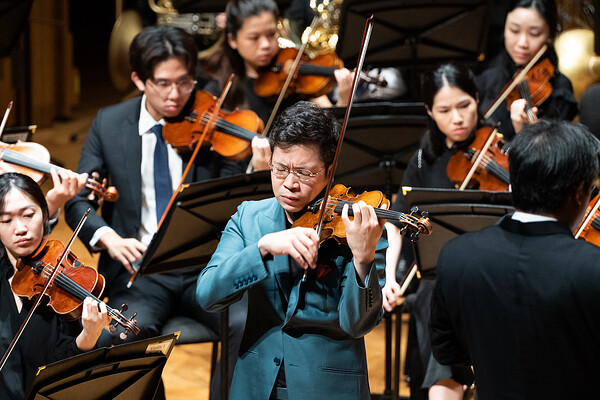Press
Review
Paul Huang Plays Tchaikovsky’s Violin Concerto

Jaded and tired of that old warhorse, the Tchaikovsky violin concerto? Paul Huang and the Orchestra of the Music Makers (OMM) with Music Director Chan Tze Law might be just the ticket to helping you believe again. So well-known is this concerto that it takes a very special performance to dust the cobwebs off and make it sparkle again – such was tonight’s concert.
In a world of violin competitions, the Tchaikovsky is so often just used as a virtuosic showcase that its music is lost amidst violinists each trying to play faster, more lyrically, more lusciously than the next. It goes without saying that Paul Huang was technically faultless, with immaculate intonation, gorgeous tone, faultless bow control and perfect octaves – but I mean it as the highest compliment when I say that it was his musicality that shone through that ‘mere’ technical mastery.
A keen communicator, as he took the audience through a fast-ish account of the first movement, it was apparent that the thirty-four year old Taiwanese-American was in full grasp of the music’s potential. With playing that often felt almost improvised, he moulded phrase after phrase with intelligence and flexibility, with such a sense of fresh discovery that often it felt as if one was hearing them for the first time.
So many violinists of late have turned to gimmickry to stand out from the crowd with this concerto – Patricia Kopanchinskaja comes to mind – that it was a complete pleasure that Huang’s performance was refreshingly short of anything faintly resembling a gimmick. Instead, he revelled in Tchaikovsky’s writing, bringing out many moments of spine-tingling pleasure through his understanding of the ebb and flow of the music’s tension, reaching its emotional core.
The OMM and Chan were worthy accomplices. Not content to just accompany, there was palpable chemistry in the partnership, the orchestra challenging Huang and whipping up the excitement in the tutti passages leading up to the cadenza. Huang again beguiled here, focussing on beauty and expression, even through the fusillades of arpeggios and double stops – his ‘Wieniawski’ Guarneri del Gesù, balanced throughout its registers, his perfect partner.
But it was the unexpected beauty of how the orchestra re-entered, sotto voce, after the violin’s soliloquy, in that almost imperceptible broadening of the tempo that was, for me, the highlight of the first movement. That was, of course, until Huang and the orchestra pulled out all the stops for a musical coup de grace in the coda, speeding up not once but twice, leaving the heart racing and the audience bursting into spontaneous, hearty applause.
The melancholic second movement Canzonetta (little song), played with mute, featured more lovely phrasing and expressive playing, with Huang’s violin singing like an opera singer, often with understated, heart-stopping beauty. Everything was completely unforced and musically intelligent, before the orchestra launched into the Finale.
The last movement is where most violinists struggle with what to say with the music. No such problem here. Starting commandingly in its introduction, Huang’s stunning staccato was a splendid foundation for his subsequent commanding exploration of the music’s thrills and spills. Huang used Tchaikovsky’s repeated passages to impish interplay, challenging the orchestra, who responded playfully like seasoned chamber music partners, with Benjamin Wong playing the clarinet solos to winning effect. The coda was as exciting and sparkling as one could hope for, with a controlled but thrilling orchestral tutti paving the way to Huang’s final violinistic fireworks. As the audience again responded with well-earned cheers and applause, I felt amazement and gratitude that I could still be surprised and so deeply moved. Surely a huge career awaits Paul Huang.
Romantic love was the common theme of the evening, and the other selections did not disappoint. Wagner’s ‘The Flying Dutchman’ overture opened the evening, with Chan whipping up the music with a bracingly quick, salt-water-in-your-face introduction, with beautifully balanced winds, and the orchestra responding to his every direction for a tight reading.
After the intermission, Chan and the OMM gave a brisk, cogently argued symphonic account of Tchaikovsky’s Romeo and Juliet Overture-Fantasy. Clear-eyed and unsentimental even in the famous love theme, the percussionists had a field day with their difficult cymbal parts flawlessly executed in the battle section, with Chan clearly giving the timpani their head in the final bars, while elsewhere the strings had a lovely bloom to them.
After the weightiness of the Wagner and Tchaikovsky works, George Gershwin’s Porgy and Bess, arranged into a ‘Symphonic Picture’ by Robert Russell Bennett in 1942 on the behest of Fritz Reiner, provided much-needed levity. With virtuoso playing in each of the sections and solos including trumpet, clarinet and saxophone, this was a showcase of the orchestra’s colour. The prominent xylophone part was particularly well-played by principal percussionist Yuru Lee. The quieter numbers were played with sensitivity, and the boisterous ones with excellent ensemble and enthusiasm – the OMM letting their hair down, winnin’ in their swingin’.